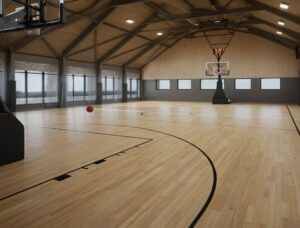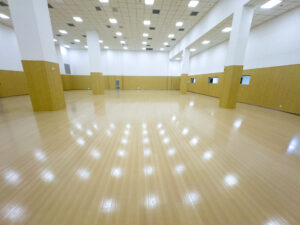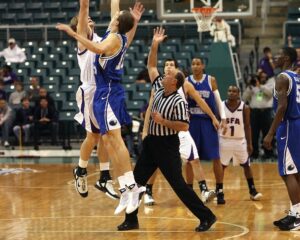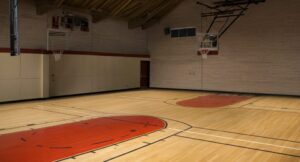Basketball court floors have evolved significantly over the years, from the early days of simple wooden surfaces to the advanced and high-performance materials used today.
The type of material used to construct a basketball court floor can significantly impact the game, player safety, and overall playing experience. This article will explore the different materials commonly used to make basketball court floors and their unique characteristics.
Whether you’re a basketball fan or simply curious about the construction of these iconic sports surfaces, read on to discover what are basketball court floors made of.
Let’s start.
Materials Used in Constructing Basketball Court Floors.
When it comes to basketball, having a high-quality court is essential. The surface on which the game is played can significantly impact the players’ performance and overall experience.
Whether it’s a professional arena, a community center, or a school gymnasium, the materials used in constructing basketball court floors play a crucial role in providing a safe and enjoyable playing environment.
In this section, we will explore the various materials commonly used in constructing basketball court floors, their benefits, and considerations for choosing the right one.
1. Hardwood.
Hardwood is the most traditional and widely recognized material used in constructing basketball court floors. Typically made from maple, it offers several advantages, making it a popular choice among athletes and sports facility managers.
Benefits
- Durability: Hardwood floors are highly resistant to wear and tear, making them ideal for high-traffic areas.
- Shock absorption: The natural elasticity of hardwood provides a cushioning effect, reducing the risk of injuries from jumps and falls.
- Ball bounce: Hardwood floors offer consistent ball bounce, allowing players to predict and control the ball’s trajectory.
- Aesthetic appeal: The classic look and feel of hardwood floors create an inviting atmosphere for players and spectators alike.
Considerations
- Maintenance: Proper maintenance, including regular sanding and refinishing, is necessary to ensure the longevity of hardwood floors.
- Cost: Hardwood floors can be more expensive upfront, but their durability and timeless appeal make them worthwhile.
2. Synthetic Flooring.
Synthetic flooring has gained popularity in recent years due to its versatility and lower maintenance requirements. Several types of synthetic materials are commonly used in constructing basketball court floors, including:
a) Thermoplastic Elastomer (TPE)
TPE is a resilient and durable synthetic material that has become a favored choice for indoor basketball courts. Its shock-absorbing properties provide excellent cushioning for players, reducing the risk of injuries during intense games. Additionally, TPE surfaces are highly customizable, allowing for various court designs and color options to match team preferences or branding. COPO Sports offers the best interlocking tiles for basketball courts.
b) Polyurethane
Polyurethane flooring offers excellent shock absorption and ball bounce characteristics. It is highly durable, resistant to moisture, and provides a consistent playing surface. Polyurethane floors can be customized with various colors and designs, allowing for branding and customization options. Copo Sports used the new upgraded Thermoplastic Elastomer (TPE) technology which way better than PP sports court
c) Rubber
Rubber flooring is known for its exceptional shock absorption, making it a preferred choice for facilities focused on injury prevention. It offers an outstanding grip, minimizing the chance of accidents caused by slipping and tripping. Rubber floors are also easy to clean and maintain, making them suitable for multi-purpose courts.
c)Vinyl Basketball Court Flooring
Vinyl flooring is a cost-effective alternative that offers durability and versatility. It provides good shock absorption, ball bounce, and traction. Vinyl floors are available in a wide range of colors and designs, allowing for customization to match branding or school colors.
Vinyl basketball court flooring is popular due to its solid strength and durability. Plastic is an ideal material for basketball courts because it provides a perfect balance between strength and flexibility.
With its similar design appearance to wood, vinyl flooring imitates the look and performance of traditional wooden floors. One of the critical advantages of vinyl basketball court flooring is its exceptional durability.
3. Modular Flooring.
Modular flooring systems consist of interlocking tiles or panels that can be easily installed and removed. These systems are highly versatile and suitable for indoor and outdoor basketball courts. Common materials used in modular flooring include plastic, polypropylene, and composite materials.
Benefits
- Portability: Modular flooring can be easily disassembled and relocated, making it an excellent choice for temporary or multi-purpose courts.
- Quick installation: The interlocking design allows for fast and hassle-free installation, minimizing downtime during construction or maintenance.
- Customization: Modular flooring is available in various colors and patterns, allowing for customization and branding opportunities.
Considerations
- Durability: While modular flooring is designed to withstand heavy use, it may not offer the same longevity as hardwood or synthetic flooring options.
- Ball bounce: The ball bounce on modular flooring may differ from traditional hardwood floors, requiring some adjustment for players.
COPO Basketball Court Flooring.
COPO is the brand to trust when it comes to sports surfaces. Whether you’re a professional athlete, a recreational player, or a facility manager, COPO’s Basketball surface is the best option for your Basketball court needs.
When it comes to sports surfaces, durability is of utmost importance. The constant wear and tear from intense gameplay and heavy foot traffic can quickly deteriorate a court if it’s not made with suitable materials. That’s where COPO’s sports tiles stand out.
Made with top-quality materials and engineered to withstand even the most challenging conditions, this surface is built to last. Not only are COPO’s interlocking tiles durable, but they also offer exceptional performance.
The unique design and construction of the surface ensure optimal ball bounce, traction, and shock absorption, enhancing gameplay and reducing the risk of injuries. Whether you’re playing basketball, tennis, or any other sport, you can trust that COPO’s Basketball flooring will provide the perfect playing experience.
Outdoor Basketball Court Flooring Material.
When it comes to outdoor basketball court flooring, asphalt is a superior choice compared to concrete. While both asphalt and concrete have similar compositions, asphalt’s firm surface offers a range of options, from smooth to rough.
This makes it ideal for basketball players as it allows for easy dribbling. However, it’s essential to be cautious when running on asphalt as it can cause scrapes and falls. Asphalt requires minimal maintenance as it has the ability to hide dirt.

Its dark color also helps to conceal grime. In addition to its player-friendly surface, asphalt is strong enough to withstand harsh weather conditions. However, it is worth noting that the entire asphalt surface can start to crack and develop surface issues over time.
This means that asphalt may not last as long as other materials and may require repairs or replacements. Despite its potential drawbacks, asphalt remains a popular choice for outdoor basketball courts due to its affordability, durability, and low maintenance requirements.
Playing on this surface provides a solid and reliable surface that can withstand the demands of intense basketball games. Whether it’s for community parks, schools, or private residences, an asphalt basketball court can provide hours of fun and physical activity for players of all ages and skill levels.
In short, selecting suitable materials for constructing basketball court floors is a crucial decision that impacts players’ performance and safety.
Whether you opt for hardwood’s timeless elegance, synthetic flooring’s versatility, or modular systems’ portability, each material has its unique set of benefits and considerations.
Understanding these factors will help you make an informed choice that ensures a top-notch playing experience for basketball enthusiasts of all levels.
Final Words.
Basketball court floors are made of a combination of different materials to ensure durability, performance, and safety. The most commonly used material is hardwood, specifically maple, due to its strength, shock absorption, and consistent bounce. Other synthetic options, such as rubber or Polyurethane and vinyl materials, are also used for Basketball courts.
The choice of flooring material depends on various factors like budget, location, and purpose of the court. Regardless of the material used, maintaining the basketball court floor regularly is essential to ensure longevity and optimal playing conditions.
FAQs
What Type of Flooring is Best for a Basketball Court?
When it comes to basketball courts, the best type of flooring is typically a hardwood surface. Hardwood floors provide a smooth, consistent playing surface for optimal ball bounce and player movement.
Additionally, hardwood floors are durable and can withstand the wear and tear of basketball games and practices. Other types of flooring, such as synthetic surfaces or rubberized materials, may be suitable for recreational or multipurpose courts but may not offer the same level of performance and playability as hardwood.
Are Basketball Floors Made of Wood?
Yes, basketball floors are typically made of wood. Wood provides the ideal surface for basketball due to its durability, shock absorption, and traction properties. However, not all basketball courts are made of wood.
Why Do Basketball Courts Have Wood Floors?
Basketball courts have wood floors for several reasons. Wood provides a durable, resilient surface that withstands players’ constant impact and movement. It also offers good traction, allowing players to make quick cuts and changes in direction without slipping.
Furthermore, wood floors have excellent shock absorption properties, reducing the risk of injury to players. Finally, the natural bounce of a wooden surface helps facilitate ball movement and enhances the overall playing experience.









